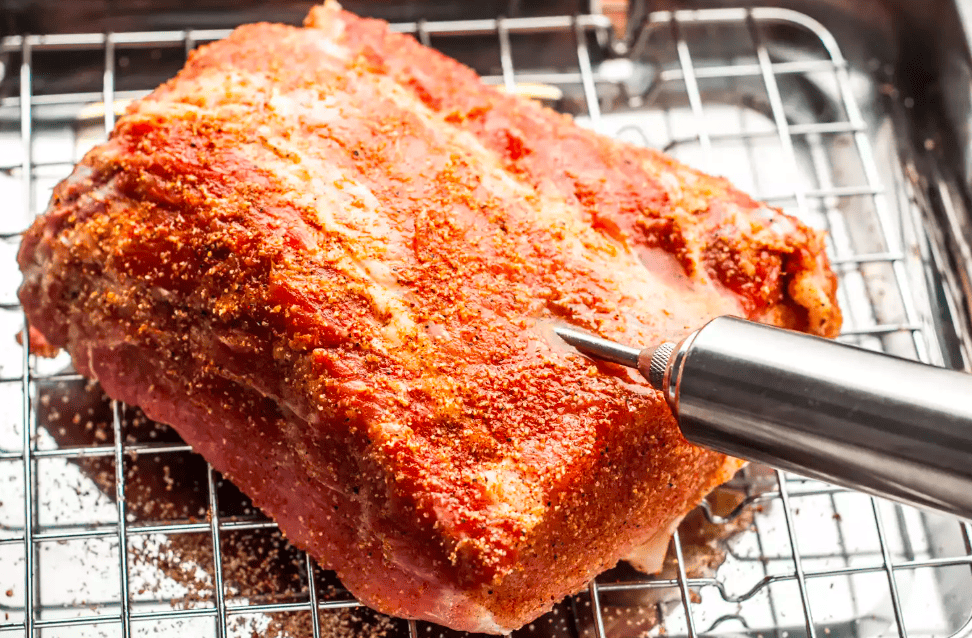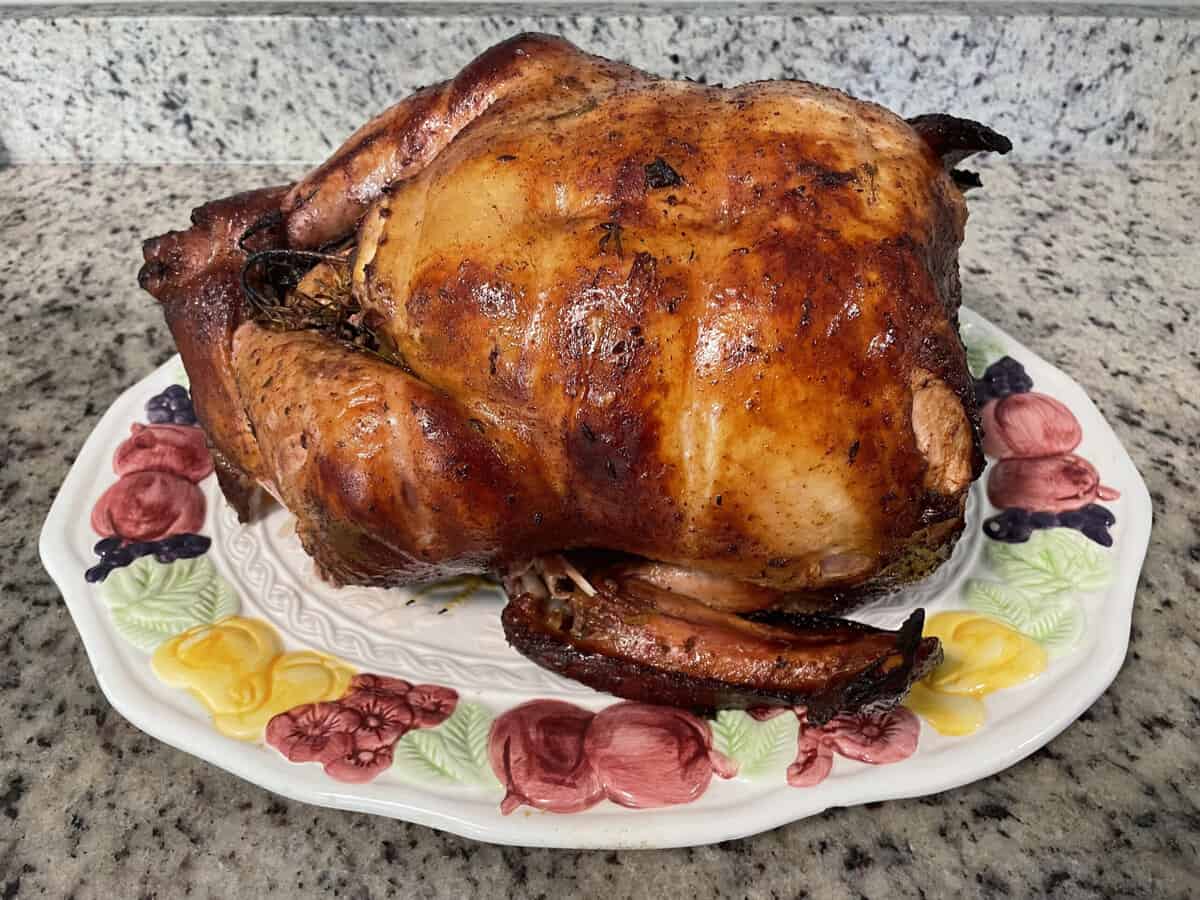So many of us BBQ chefs are skipping the whole marinade thing and going straight to the huge meat injection needles these days. It’s like we crave an inside fix with all this meat just waiting to be juiced for the smokers and grills, so we’re like injection information junkies.
It’s all good. We’ve got you covered. Competition judges inject meat like it’s going out of style, so if you’re entering a contest or just a weekend backyard brisket bomber you might as well break out the syringes, needles, and Sweet Jamaican Lemon Oil right now.
We’ve got a point or two to make here about how to inject meat. No wait, it’s more like 17 of them:
1. Don’t Inject Cold Fluids
It will just lengthen the cooking process. Trust me, I did this for our latest Thanksgiving turkey and learned this lesson after the fact. Let the liquids reach room temperature or take the chill off in the microwave first.

2. Startup Injectors are okay…
The standard-issue supermarket version is a good startup product to get your feet wet, so to speak.
My maiden voyage was a simple Publix Cajun Butter Marinade packaged with a plastic injector and one needle. I used it on our Thanksgiving turkey and the end result was delicious.
Just be sure to keep it clean to avoid bacteria the next time, and know your limitations since there is only one all-purpose needle.
3. … But These Work Even Better
There’s no need to waste over 20 bucks on an injector unless you smoke whole hams or something.
Save your money for bigger briskets. The Tri-Sworker stainless steel model is $17 on Amazon and part of a kit that has everything you need. I like the big thumbhole and don’t need one with two additional finger holes, but that’s a personal choice so decide on that first.
There is little separation from Amazon’s No. 1 rank in this category and No. 100, as product differences are few. Also, the jumbo pistol grip injectors can be difficult for leverage, and why use a gun on meat twice, anyway?
4. Stay Organized with a Carrying Case
Spend another five or 10 bucks on an injector that comes with a case, and you’ll always know where your stuff is the next time you need it.
Ofargo is top-rated on Amazon, and this one comes with a case to keep everything together. It’s even more important to be organized with injectors because the needles are delicate and dangerous. You don’t want to reach into a box and get jabbed.
5. Bigger Barrels Mean Faster Results
The larger the syringe barrel, the less time spent sucking in liquids. Just a little extra capacity can make a big difference when you’re sticking a large hunk of meat like a turkey.
The BBQ Monster is a little more expensive in the mid to upper $30s, but man just look at that fat barrel ready for a BBQ championship. Again, just remember that too much length could cost leverage.

6. Matching Marinades with Meat
Injecting meat is like marinating, except from the inside out. Here’s a good guide to preparing the right kind of liquid to inject into the appropriate meat, courtesy of Charmate over in New Zealand. It makes about one liter, or a little over a quart.
- Chicken: 2 tbsp salt + 1 tbsp sugar + 4 cups reduced salt chicken stock.
- Beef: 2 tbsp salt + 1 tbsp sugar + 2 tsp Worchestershire + 4 cups reduced salt beef stock.
- Pork: 2 tbsp salt + 1 tbsp sugar/1 tbsp maple syrup + 1 tbsp Worchestershire + 2 tbsp rice/cider vinegar + 1 cup reduced-salt chicken/pork/beef stock or apple juice/cider + 3 cups water.
7. Naturally Dry Meats Need Injections
Inject whatever you want, but do it especially for large meats that are naturally dry and bland. These include beef round roast, 2x thick pork chops, pork loin, and leg of lamb.
8. What to Inject into Turkey
Here’s a good turkey injection recipe. It includes chicken broth, butter, salt, garlic powder, onion powder, hot sauce, and lemon juice. Just melt the stick of butter and mix it all. Then experiment with different flavors each year.
9. Watch Out for too Much Salt
Don’t overdo the salt or it could remove some of the moisture during the process, especially if you have already brined the bird or if you use salted butter. This is a big mistake to avoid.
10. Choose the Right Needle
A good marinade injector kit like that one will typically have three or four meat needles customized to different types of injection needs.
One large needle will have a single hole at the end, for injecting donuts or for injecting meats where you have thicker liquid that has to get through. Another large needle will have holes in the side, for use with a turkey or brisket to spread liquid evenly.
It also has two smaller ones with perforated holes in the sides, for thinner cuts and more delicate foods like fish, so the oils can be distributed without breaking apart the skin. Practice with each and you’ll be an injection pro.
11. Dip the Plunger First
Before you do anything, dunk the end of the syringe plunger into your food oil so it’s lubricated. Then put it into the barrel and it will push and pull with ease.
12. Inject the Right Amount
Some injectors come with an ebook filled with key information such as how much liquid to inject in various types of meat. The Ofargo injector has a measurement window so you know the amount of liquid you are pushing.
For a turkey, each side of the breast and each thigh should be injected with about a half-ounce of marinade for every five pounds of turkey. So for a 20-pounder, that’s two ounces in each of those areas, just as a ballpark amount.
13. Easy Does it
You’ll need enough patience to inject the liquid slowly.
If you shoot it fast like you’re at a shooting gallery it’s going to come back at you. If you’re doing a turkey injection, start at the top of your turkey’s breast and then gradually inject in a few locations as you work your way down.
You’ll see it gradually plump up and be even more excited to roast it on the smoker.

14. Attack at Different Angles
Try using the same hole and injecting at different angles, so you minimize leakage. As you go all around the meat, aim at different angles and…
15. Be Prepared for Puddles
If you do all this on a cutting board, your meat is going to be sitting in liquid that’s starting to dribble over off the sides.
There will be leakage, but most of your injection will be absorbed inside the meat and expand in the muscles. Prepare for a messy situation by spreading out an old towel under the cutting board or draining the board into an adjacent sink halfway through.
Bottom line, expect a little prep-area cleanup before you get to grilling or right after you plop the super-juicy meat onto your BBQ grate, whether it’s a ceramic smoker, offset smoker, barrel smoker, pellet wood grill, or gas grill.
16. Flip Your Turkey if it’s Injected
After about four hours of smoking my turkey, I realized that the injection fluids were leaving a lot of plump bulges at the bottom, just a couple of inches above the roasting pan liquid.
At that point, I carefully flipped the turkey over, and gradually the breast side browned up as nicely as the backside. You might want to just plan to do that halfway through a turkey injection roast.
17. Clean up and Maintain Regularly
Always wash BBQ meat injectors by hand, stainless steel or not. They’ll last longer. Brushes should be included so you can scrub inside the needles as well as the syringe. Silicone O-rings will wear out and are usually included and easy to replace.
There is a lot of upside to barbecuing and grilling meat in its own juices and then savoring the natural flavor at the dinner table. That’s how Aaron Franklin does it with his famous Franklin BBQ briskets in Austin, Texas. But even he advises grillers to do their own thing, try something new each time, and make your own style. For many of us, that includes lots of injections.

